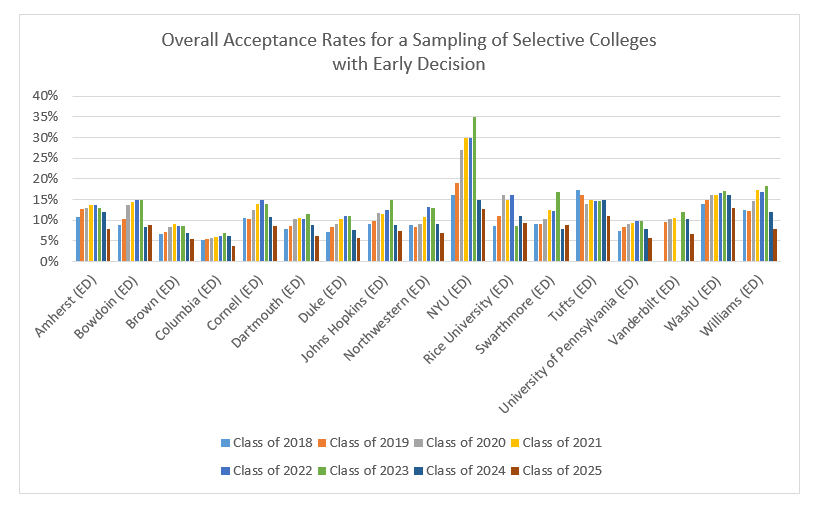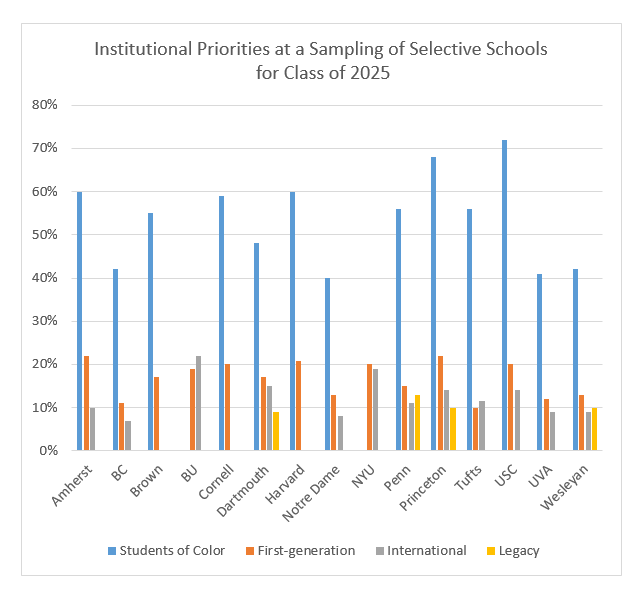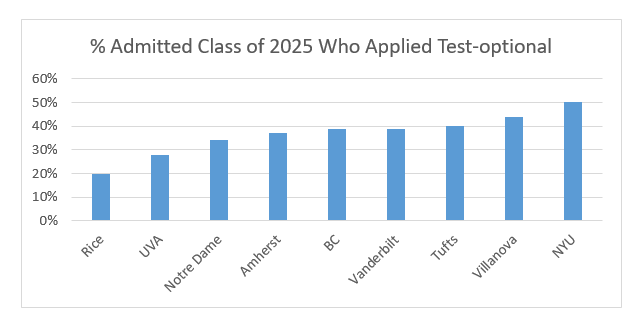 This year’s college admissions cycle was like no other—and it’s not over yet! Early applications surged at selective schools and resulted in more deferrals. Regular admissions saw huge increases in applications for selective schools as well, and waitlists are expected to be long and active this spring and summer.
This year’s college admissions cycle was like no other—and it’s not over yet! Early applications surged at selective schools and resulted in more deferrals. Regular admissions saw huge increases in applications for selective schools as well, and waitlists are expected to be long and active this spring and summer.
Several factors created a perfect storm of applications. The reduced ability to take standardized tests in-person—and colleges adopting test-optional policies as a result—gave many students unrealistic hopes of being accepted to their dream school and led to an increase in applications to reach schools. In addition, restrictions created by the pandemic gave students more time to complete college applications while they were stuck at home. Finally, the lack of opportunity to visit colleges in person may have led students to create longer college lists, due to their uncertainty about which colleges would truly be a good fit.
As a follow-up to our previous blog on Early Admissions Trends for the Class of 2025, here’s an in-depth review of this year’s regular decision and overall admissions trends. To assist applicants who will be applying this fall, our analysis will conclude with a helpful list of tips for crafting your “best-fit” college list.
Rising Applicant Numbers, Lower Acceptance Rates
This year, regular decision acceptance rates at many selective schools plummeted. Highly sought-after private and public universities received a staggering number of applications combined with the fact that many of these schools fill a large portion of their freshman class through early admissions. The Common App reported an 11% increase in applications this year, but only a 2% increase in unique applicants, meaning that almost the same number of students applied to college—they just applied to more schools than ever before.
Many selective schools with new test-optional policies (due to the pandemic) received a record-breaking number of applications this year. Schools that saw a large increase in applications from the previous year include Colgate (103%), Columbia (51%), Harvard (42%), and MIT (66%).
Schools that were already staggeringly selective became even more so, with overall acceptance rates under 5%, at universities including Columbia (3.7%), Harvard (3.4%), MIT (4%), Princeton (4%), and Yale (4.6%). BC dropped from 24% last year to 18.9% this year. The charts below show a trend among many selective schools of a slight increase in acceptance rates for the Classes of 2022 and 2023 followed by a dip in acceptance rates for the Classes of 2024 and 2025, during the pandemic. This pattern was even more pronounced for colleges with Early Decision plans than colleges with Early Action plans.
As a reminder, early decision is binding as universities are guaranteed applicants’ attendance, as compared with early action, which is non-binding and gives students until May 1st to decide. As a result, colleges with early decision programs tend to admit a higher percentage of early applicants, who have demonstrated such strong interest, and their binding commitment helps increase admissions yield for the incoming class.
Larger Percentages of Freshman Classes Filled with Early Applicants
Some schools continue to admit large portions of the freshman class through early admissions, making the regular admissions cycle even more competitive. More students tend to apply through regular decision, so they are competing for fewer remaining positions in the class.
Boston University, Cornell, Dartmouth, Duke, Middlebury, Northwestern, Skidmore, the University of Pennsylvania, and Washington University in St. Louis admit 40% or more of their incoming class through their early decision program. The chart below shows the percentage of the Class of 2024 filled with early decision admits.
*Columbia, Stanford, University of Chicago, Washington University in St. Louis, and Williams do not release early and regular acceptance rates, only overall acceptance rates.
Early decision tends to have a higher acceptance rate than early action and regular decision; and schools that offer early decision have a larger variance between early and regular acceptance rates than schools with early action programs. See the charts below.
Increasing Diversity
Increasing the diversity of incoming classes has become a top priority for the admissions departments at many schools. This includes international applicants, students from varying socioeconomic and ethnic backgrounds, and first-generation college students. Schools are seeking top-quality students from diverse backgrounds through a variety of programs, including American Talent Initiative, QuestBridge, the KIPP Foundation, and A Better Chance.
According to The New York Times, “The aftermath of the George Floyd protests and a decreased reliance on standardized tests have led to more diverse admissions at elite universities.” NYU admitted its most diverse freshman class, including 29% of admits who are underrepresented students. Stu Schmill, Dean of Admissions at MIT, said “I can tell you that there is a higher percentage of students of color this year than last.” MIT will not release the breakdown of the admitted class until enrollment is determined. This chart demonstrates the makeup of admitted classes at several selective universities.
Many colleges credit new test-optional policies with increasing the diversity of their applicant pool.
Class Size and Class of 2024 Deferrals
The fall of 2020, undergraduate enrollment fell 4.4% nationwide, according to data from the National Student Clearinghouse Research Center. Freshman enrollment declined 13%, which brings us to the effect of deferrals from the Class of 2024 on admissions for the Class of 2025.
Some schools admitted lower numbers for the Class of 2025, due to large numbers enrolling after deferral from the Class of 2024. At Princeton, over 200 students deferred enrollment to the fall of 2025; as a result, the school admitted 20% fewer students than normal. Duke had 10% of the Class of 2024 defer for a year, and also admitted fewer students early and regular decision the Class of 2025. Williams had 130 students defer enrollment, and admitted 250 fewer students this year than last year.
Other schools decided to remain consistent in admission numbers this year, despite deferrals. Yale had 20% of the Class of 2024 defer (typically only 3-4% of students defer admission), and yet they chose to admit a similar number of students to the Class of 2025 as in previous years. Harvard also admitted a full class despite 349 deferrals joining the Class of 2025. “Harvard is committed to opening the doors of opportunity to all talented students, even if it means confronting the challenge of accommodating more students on campus next year,” said Dean of the Faculty of Arts and Sciences Claudine Gay. MIT also plans to enroll a larger class than usual due to deferrals (87 students last year vs. the typical 10-15 students). Rice admitted its largest class ever as part of a recently announced plan to expand the undergraduate student body.
Demonstrated Interest Matters Even More
As schools receive more and more applications, it has become increasingly difficult to predict yield (the number of admitted students who will attend). According to Georgetown’s, Dean of Undergraduate Admissions Charles Deacon, receiving more qualified applications requires admissions officers to place greater importance on the student’s interest in the school when determining admissions decisions.
Demonstrated interest refers to the ways in which a student shows how engaged they are in the school and the extent to which they are committed to attending if admitted. Most often, interest is assessed through college visits and contact with the college. Inside Higher Ed points out that this is particularly important for students with high SAT scores. Colleges do not want to be considered a “safety school,” and may avoid high-scoring applicants who demonstrate little interest beyond applying.
For tips on how to demonstrate interest to your top school choices, see our blog.
Delaying Admission
Many schools offered delayed admission to incoming freshmen, providing spring acceptances or asking the students to begin the following fall.
Tulane offers a Spring Scholars program, whereby students participate in study abroad, internships, or other academic activities in the fall and matriculate in the spring semester. Cornell admits 50 students to the First-Year Spring Admission (FYSA) program, which was established in 2015 to increase access to a Cornell education. Hamilton aims to enroll about 45 first-year students in their spring admission program each year. This allows them to offer admission to additional strong applicants, while also filling spots created by current students who are studying abroad during the spring semester. USC aims to enroll about 600 freshman spring admits each year. The Brandeis Midyear Program offers 100 freshmen students enrollment each year.
Tips for Future Applicants
Think carefully about your college list. When crafting your college list, reflect on your goals, interests, and values. Make sure that you would be happy to attend every school on your list. Do not apply to a university that is not a good fit or about which you have reservations. Be very realistic about your chances and have grounded expectations. Your college list should have a healthy distribution of reach, target, and safe schools. Apply to 10-12 colleges so that you have enough time to prepare high-quality applications, and still manage the process alongside your academic responsibilities senior year.
Demonstrate interest. If possible, visit all of the schools in which you are interested. When you visit, register with the admissions reception desk. Many schools track visits, and see this as the strongest possible way to demonstrate interest. If you are applying for early admission, visit the college by November 15. If you are applying for regular admission, visit in the fall of your senior year, or by February 15 at the latest.
Know your colleges. Many colleges go a step further, and emphasize “informed” interest. It’s not enough to visit the college; you need to observe the features of each college that differentiate it from other schools, and that align with your own interests and goals. Be prepared to inform colleges in your essays and interviews of specific reasons why you wish to attend.
Be strategic with early admissions. While early acceptance rates tend to be higher than regular acceptance rates, early admissions have become harder to predict. Think carefully and strategically about your early admissions choice.
Highlight your heritage. Many universities have made increasing the diversity of incoming classes a top admissions priority. If you identify with an under-represented minority, participate in diversity days hosted by the college, if appropriate.
Engage in school. In order to maximize your options in the college admissions process, try to reach your potential throughout high school. Engage in your academics: do your homework, participate in classes, choose interesting projects, speak with your teachers if you have questions, and manage your time well. Identify your interests, and choose extracurricular activities that are meaningful to you; participate with commitment and continuity; and seek leadership roles in the activities you enjoy the most. Engaging in your coursework and activities in high school will also position you well for making the most of your college years.
The college admissions process can be overwhelming, and it may feel difficult to know where to start. At Collegiate Gateway, we are eager to share our expertise and guide you on the path to your “best fit” college. Please feel free to contact us! As always, we’re happy to help!
Check out our events page for future college admissions presentations.







